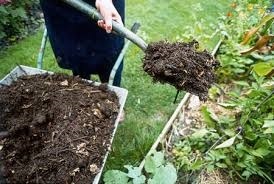 |
| Staking a tall bare rooted tree. |
Here we are into another month and closer to Spring, with camellias blooming, magnolia buds beginning to burst and spring bulbs thinking it is mild enough to bloom. Going by my past notes we still have proper winter weather ahead this month before we can leap fully into spring. Soil along with plant's need continual cold temperatures to be at peek performance during the growing seasons. Here in our garden the hard graft is almost over, whew!, soon it will be time to get creative and dress the garden by planting out, shifting and feeding.
Liquid feed annuals and perennials that have been nursed through winter, roots are starting to take in nutrients to plump up buds.
Roses and hydrangeas are still getting the winter prune here, only flower carpet roses to go, this variety bush up with small non hard wood branching, if they are large, trim with a hedge trimmer, if newly planted prune back the flowered ends to hard wood.
Hydrangeas: I have taken cuttings from Annabelle hydrangeas hardened stems that flowered last season.Thick rather than thin cuttings are best about 12" long, dip cuttings in rooting hormone (this is optional) and insert cut end down into damp river sand, around the edge of the pot rather than the middle, water well and allow to drain. Annabelle hydrangea is lovely with white lacy flowers and is quick and easily grown from cuttings as well as root sections, they give a great show growing in a group.
Staking Trees: I have been noticing newly planted tall grafted tree's planted in gardens with out stakes, while the ground is firm and winds are few during winter they are settled but come spring with unpredictable weather these trees will be whipped about with wind with roots moving when they should be firm in the ground making the needed feeding roots. Tree's left un staked take much longer to make the roots needed to anchor them and grow slower, sometimes not at all.
Seeds can be sown of cottage annuals like cosmos, cornflowers, love in the mist, snapdragon and alyssum, all can be sown under glass in trays up off the cold ground in a warm area. More tender annuals need to wait until it is warmer unless you have a heated glass house. Perennials and annuals already putting out growth need to be protected from any sudden freezing.
Vegetable gardens are enjoying the sunny days with frosts helping to break down soil. Birds will hungry and starting to nest so cover leaf veg with netting or frost cloth to keep them off. This month is time for sowing veg seeds to germinate in a warm well lit place to be ready for pricking out into punnets then planted into a warm spring garden.
Fruit Trees are still available in Garden Centres, if you would like an apple tree but feel your garden is too small why not look at apple ballerina, a very slim non branching variety of apple with Medium, red skin, Crisp, juicy, nice eating and cooking apples, Ballerina grows to 3-4m tall by 30cm wide perfect for adding height, blossom and fruit to a small garden.
Grape pruning needs to finish soon before sap rises, to prune a fruiting leader remove all new long growth on the vine other than the fruiting leader, on the leaders prune each new growth back to the second bud. These fruiting buds should be around a hand space apart to ensure adequate sized fruit, this means removing some of the new bud growth along the top of the leader and all of the new bud growth growing underneath. Some of these new budding top growths will throw two lots of bud branch, remove the least stronger one leaving only one lot of double buds to produce fruit.
Keep an eye on peach bud burst, in milder gardens it will happen early. A copper spray right at bud burst will help with leaf curl.
Cheers, Linda
 |
| Magnolia blooms snug in fury buds. |







